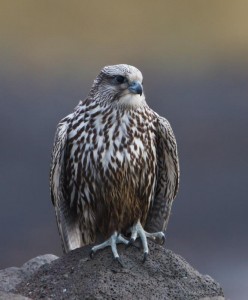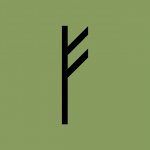
Gyrfalcon. Plumage ranges from dark gray to brown to white and varies greatly. Photo by Omar Runolfsson.
Frejya has appeared to me as a stocky young woman against a backdrop of tall spruce forest, standing on the snow beside the kind of weaving, shallow streams that develop in the north as winter moves into spring. She comes as a spring goddess, evidenced by the height and intensity of the sun. (One of the nice things about a vision is that you can look directly into the sun without feeling pain in your eyes.) When I say she is stocky, I don’t mean fat: her shoulders are broad and she is proportioned like a tall woman. Her rib cage is large, like the stout breast of the gyrfalcon. She has a brown cloak, curling brown hair and glistening brown eyes. Some describe Frejya as blond, but to me she appears in falcon coloring. What those who have seen Frejya mostly comment on, however, is her mouth: a small, very red, well-shaped mouth with lips curved in a joyful yet seductive smile. It is an entrancing smile, a smile that says she knows just about everything. I do not believe that Frejya would have had to have slept with the dwarves to obtain the Brisingamen Necklace; she must have done so only to please herself. To obtain the necklace she would only have had to spread those red lips in the smile no creature could resist. But I digress.Frejya’s Amazonian proportions and her seductive manner place her in the “maiden” category for those who see goddesses in terms of maiden-mother-crone. Yet the fertile, family-focused boar is usually associated with motherhood, and Norse pagans appear to have regarded Frejya as a benevolent goddess bestowing wealth and favors. Her rune is among the most auspicious, and Cooper describes its divinatory meaning as “Good fortune, fertility, increase in property and success in endeavors.” These are qualities that proclaim “mother.”

Frejya’s rune Fehu (FAY-who).
The point of intersection between the fir, falcon, and boar is, of course, death. The gyrfalcon is a fierce hunter who winters in the frozen world. The Norway Spruce thrives in cold environments and remains forever green. The boar is also fierce in her own way, and carrion is a major part of her diet. As described in the last post, there are dying and resurrecting gods and goddesses from other European and Middle Eastern cultures with pine, pig, or falcon associations, but we don’t really need these examples to establish the point.
Frejya’s representation throughout the lifecycle suggests an affinity with the sun, which defines the cycle of the year. Her association with both the winter and the summer solstices reaffirm this connection, as does the Yule fire and the summer bonfires. Frejya’s amber necklace represents her command over the sun and hence the passage of time. Those who see Frejya as blond may be focusing on her sun aspect, perhaps dazzled by the brightness of her nimbus. It is interesting in this regard that the Egyptian sun god Horus also takes the form of a falcon.Although Frejya is a goddess for all seasons and all ages, I want to explore Frejya’s death aspect more closely. I will do so in a later installment of this series.



Beautiful Imagery!
Yes, she is full of striking visuals.
Yes, she is a visual feast.